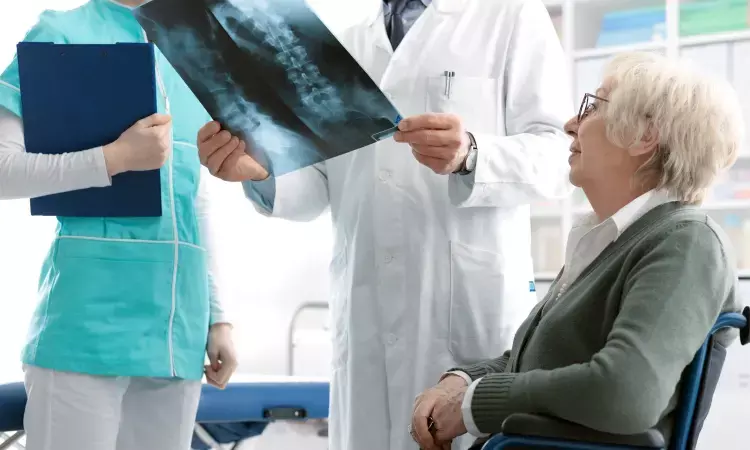- Home
- Medical news & Guidelines
- Anesthesiology
- Cardiology and CTVS
- Critical Care
- Dentistry
- Dermatology
- Diabetes and Endocrinology
- ENT
- Gastroenterology
- Medicine
- Nephrology
- Neurology
- Obstretics-Gynaecology
- Oncology
- Ophthalmology
- Orthopaedics
- Pediatrics-Neonatology
- Psychiatry
- Pulmonology
- Radiology
- Surgery
- Urology
- Laboratory Medicine
- Diet
- Nursing
- Paramedical
- Physiotherapy
- Health news
- Fact Check
- Bone Health Fact Check
- Brain Health Fact Check
- Cancer Related Fact Check
- Child Care Fact Check
- Dental and oral health fact check
- Diabetes and metabolic health fact check
- Diet and Nutrition Fact Check
- Eye and ENT Care Fact Check
- Fitness fact check
- Gut health fact check
- Heart health fact check
- Kidney health fact check
- Medical education fact check
- Men's health fact check
- Respiratory fact check
- Skin and hair care fact check
- Vaccine and Immunization fact check
- Women's health fact check
- AYUSH
- State News
- Andaman and Nicobar Islands
- Andhra Pradesh
- Arunachal Pradesh
- Assam
- Bihar
- Chandigarh
- Chattisgarh
- Dadra and Nagar Haveli
- Daman and Diu
- Delhi
- Goa
- Gujarat
- Haryana
- Himachal Pradesh
- Jammu & Kashmir
- Jharkhand
- Karnataka
- Kerala
- Ladakh
- Lakshadweep
- Madhya Pradesh
- Maharashtra
- Manipur
- Meghalaya
- Mizoram
- Nagaland
- Odisha
- Puducherry
- Punjab
- Rajasthan
- Sikkim
- Tamil Nadu
- Telangana
- Tripura
- Uttar Pradesh
- Uttrakhand
- West Bengal
- Medical Education
- Industry
Elevated blood lead levels may raise osteoporosis risk in women.

Osteoporosis is characterized by bone mass loss and bone microstructure degeneration, making bones fragile and brittle with a higher risk of fractures. Risk factors for osteoporosis can be modifiable and non-modifiable. A lack of essential minerals like calcium and magnesium can contribute to osteoporosis development. Studies have shown that trace elements are essential for bone growth and metabolism, but their specific roles in osteoporosis are poorly understood.
A study published in the Journal of Orthopaedic Surgery and Research revealed that higher blood lead levels are related to reduced bone density in women's lumbar spine, pelvis, and total femur. On the other hand, increased blood selenium levels are associated with increased bone density in the pelvis. No association was found for other trace elements such as iron, zinc, copper, manganese, cadmium, or mercury. Researchers also suggested that elevated blood lead levels may raise osteoporosis risk in women, while other trace elements do not have such an effect.
Researchers from Xiangya School of Nursing and Endocrinology Research Center, China, conducted a cross-sectional study using NHANES data (2011-2016) and analyzed BMD in the lumbar spine, pelvic, and total femur with blood trace elements. They used multivariate linear and logistic regression models to determine the association related to BMD, trace elements and osteoporosis risk among US adults.
Key findings from the study are:
· Higher blood lead levels were found to be associated with decreased BMD in the lumbar spine (LS-BMD), Pelvic (PV-BMD) and total femur (TF-BMD in females.
· Higher blood Selenium levels were associated with increased PV-BMD in females.
· There was no linear association between BMD and other blood trace elements.
· The association was significant between lead levels, the prevalence of low BMD, and the prevalence of osteoporosis.
· No association was observed between other blood trace elements and low BMD/osteoporosis.
They said that the study offers a comprehensive understanding of the relationship between blood trace elements and BMD. Based on the study's findings, high levels of blood lead (Pb) are detrimental to bone mass in women.
Study limitations include cross-sectional analysis, covariates adjustments, and non-inclusion of confounding variables like diet and lifestyle, which may have affected the correction between blood trace elements and BMD.
Reference:
Wu, C., Xiao, Y. & Jiang, Y. Associations of blood trace elements with bone mineral density: a population-based study in US adults. J Orthop Surg Res 18, 827 (2023). https://doi.org/10.1186/s13018-023-04329-9
BDS, MDS in Periodontics and Implantology
Dr. Aditi Yadav is a BDS, MDS in Periodontics and Implantology. She has a clinical experience of 5 years as a laser dental surgeon. She also has a Diploma in clinical research and pharmacovigilance and is a Certified data scientist. She is currently working as a content developer in e-health services. Dr. Yadav has a keen interest in Medical Journalism and is actively involved in Medical Research writing.
Dr Kamal Kant Kohli-MBBS, DTCD- a chest specialist with more than 30 years of practice and a flair for writing clinical articles, Dr Kamal Kant Kohli joined Medical Dialogues as a Chief Editor of Medical News. Besides writing articles, as an editor, he proofreads and verifies all the medical content published on Medical Dialogues including those coming from journals, studies,medical conferences,guidelines etc. Email: drkohli@medicaldialogues.in. Contact no. 011-43720751


